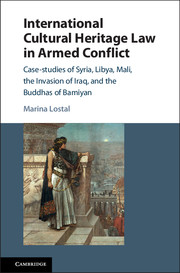 International Cultural Heritage Law in Armed Conflict
International Cultural Heritage Law in Armed Conflict Book contents
- International Cultural Heritage Law in Armed Conflict
- International Cultural Heritage Law in Armed Conflict
- Copyright page
- Dedication
- Contents
- Foreword
- Acknowledgments
- List of Treaties and Other Legal Instruments
- Abbreviations
- Introduction
- 1 Two Wrong Ways of Thinking about the Legal Protection of Cultural Property in Armed Conflict
- 2 The Systemic Approach
- 3 The World Heritage Convention as the Field’s Common Legal Denominator
- 4 Syria
- 5 Libya and Mali
- 6 2003 Iraq and Afghanistan
- Conclusion
- Bibliography
- Index
- References
Bibliography
Published online by Cambridge University Press: 11 May 2017
- International Cultural Heritage Law in Armed Conflict
- International Cultural Heritage Law in Armed Conflict
- Copyright page
- Dedication
- Contents
- Foreword
- Acknowledgments
- List of Treaties and Other Legal Instruments
- Abbreviations
- Introduction
- 1 Two Wrong Ways of Thinking about the Legal Protection of Cultural Property in Armed Conflict
- 2 The Systemic Approach
- 3 The World Heritage Convention as the Field’s Common Legal Denominator
- 4 Syria
- 5 Libya and Mali
- 6 2003 Iraq and Afghanistan
- Conclusion
- Bibliography
- Index
- References
- Type
- Chapter
- Information
- International Cultural Heritage Law in Armed ConflictCase-Studies of Syria, Libya, Mali, the Invasion of Iraq, and the Buddhas of Bamiyan, pp. 169 - 184Publisher: Cambridge University PressPrint publication year: 2017


